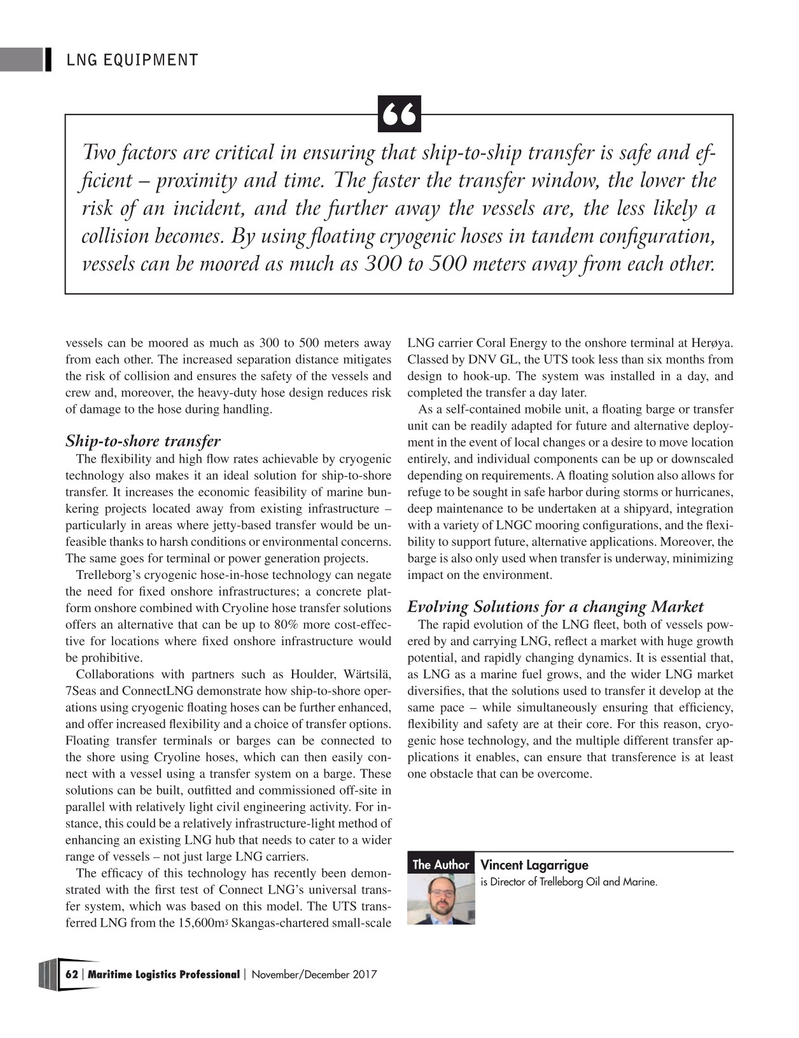
Page 62: of Maritime Logistics Professional Magazine (Nov/Dec 2017)
GREEN PORTS
Read this page in Pdf, Flash or Html5 edition of Nov/Dec 2017 Maritime Logistics Professional Magazine
LNG EQUIPMENT
Two factors are critical in ensuring that ship-to-ship transfer is safe and ef- fcient – proximity and time. The faster the transfer window, the lower the risk of an incident, and the further away the vessels are, the less likely a collision becomes. By using foating cryogenic hoses in tandem confguration, vessels can be moored as much as 300 to 500 meters away from each other.
vessels can be moored as much as 300 to 500 meters away LNG carrier Coral Energy to the onshore terminal at Herøya. from each other. The increased separation distance mitigates Classed by DNV GL, the UTS took less than six months from the risk of collision and ensures the safety of the vessels and design to hook-up. The system was installed in a day, and crew and, moreover, the heavy-duty hose design reduces risk completed the transfer a day later.
of damage to the hose during handling. As a self-contained mobile unit, a foating barge or transfer unit can be readily adapted for future and alternative deploy-
Ship-to-shore transfer ment in the event of local changes or a desire to move location
The fexibility and high fow rates achievable by cryogenic entirely, and individual components can be up or downscaled technology also makes it an ideal solution for ship-to-shore depending on requirements. A foating solution also allows for transfer. It increases the economic feasibility of marine bun- refuge to be sought in safe harbor during storms or hurricanes, kering projects located away from existing infrastructure – deep maintenance to be undertaken at a shipyard, integration particularly in areas where jetty-based transfer would be un- with a variety of LNGC mooring confgurations, and the fexi- feasible thanks to harsh conditions or environmental concerns. bility to support future, alternative applications. Moreover, the
The same goes for terminal or power generation projects. barge is also only used when transfer is underway, minimizing
Trelleborg’s cryogenic hose-in-hose technology can negate impact on the environment.
the need for fxed onshore infrastructures; a concrete plat- form onshore combined with Cryoline hose transfer solutions Evolving Solutions for a changing Market offers an alternative that can be up to 80% more cost-effec- The rapid evolution of the LNG feet, both of vessels pow- tive for locations where fxed onshore infrastructure would ered by and carrying LNG, refect a market with huge growth be prohibitive. potential, and rapidly changing dynamics. It is essential that,
Collaborations with partners such as Houlder, Wärtsilä, as LNG as a marine fuel grows, and the wider LNG market 7Seas and ConnectLNG demonstrate how ship-to-shore oper- diversifes, that the solutions used to transfer it develop at the ations using cryogenic foating hoses can be further enhanced, same pace – while simultaneously ensuring that effciency, and offer increased fexibility and a choice of transfer options. fexibility and safety are at their core. For this reason, cryo-
Floating transfer terminals or barges can be connected to genic hose technology, and the multiple different transfer ap- the shore using Cryoline hoses, which can then easily con- plications it enables, can ensure that transference is at least nect with a vessel using a transfer system on a barge. These one obstacle that can be overcome.
solutions can be built, outftted and commissioned off-site in parallel with relatively light civil engineering activity. For in- stance, this could be a relatively infrastructure-light method of enhancing an existing LNG hub that needs to cater to a wider range of vessels – not just large LNG carriers.
The Author
Vincent Lagarrigue
The effcacy of this technology has recently been demon- is Director of Trelleborg Oil and Marine.
strated with the frst test of Connect LNG’s universal trans- fer system, which was based on this model. The UTS trans- ferred LNG from the 15,600m? Skangas-chartered small-scale 62 Maritime Logistics Professional November/December 2017 | |

 61
61

 3rd Cover
3rd Cover
